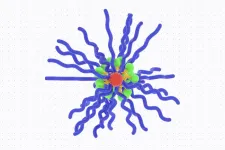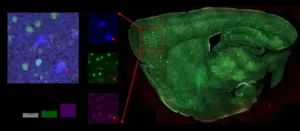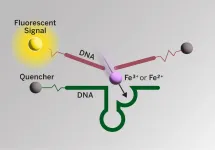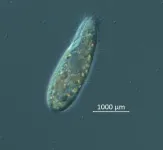(Press-News.org) CAMBRIDGE, MA — Cancer drugs that stimulate the body’s immune system to attack tumors are a promising way to treat many types of cancer. However, some of these drugs produce too much systemic inflammation when delivered intravenously, making them harmful to use in patients.
MIT researchers have now come up with a possible way to get around that obstacle. In a new study, they showed that when immunostimulatory prodrugs — inactive drugs that require activation in the body — are tuned for optimal activation timing, the drugs provoke the immune system to attack tumors without the side effects that occur when the active form of the drug is given.
The researchers designed prodrugs with bottlebrush-like structures based on a class of compounds called imidazoquinolines (IMDs). Mice treated with these bottlebrush prodrugs designed with optimized activation kinetics showed a significant reduction in tumor growth, with no side effects. The researchers hope that this approach could be used to boost immune system responses in cancer patients, especially when combined with other immunotherapy drugs or cancer vaccines.
“Our bottlebrush prodrug library enabled us to show an immunological effect of controlling immunotherapy kinetics, allowing us to boost immune responses while minimizing the side effects,” says Sachin Bhagchandani, an MIT graduate student who is the lead author of the study. “This kind of approach opens up avenues for scientists who want to decouple toxicity from some promising immunotherapy agents.”
Jeremiah Johnson, an MIT professor of chemistry, and Darrell Irvine, the Underwood-Prescott Professor with appointments in MIT’s departments of Biological Engineering and of Materials Science and Engineering, are the senior authors of the paper, which appears today in Science Advances. Irvine is also an associate director of MIT’s Koch Institute for Integrative Cancer Research and a member of the Ragon Institute of MGH, MIT, and Harvard.
Tailored prodrugs
Organic molecules known as IMDs bind to cell receptors called Toll-like receptors that are found on macrophages and other cells of the innate immune system. When activated, these cells begin producing cytokines and other inflammatory molecules.
In 1997, the FDA approved topical IMD drugs to treat certain types of skin cancer. Since then, many other IMD drugs have been tested in clinical trials for a variety of types of cancer, but none of these were approved, in part because the drugs produced too much systemic inflammation.
The MIT team set out to explore whether prodrugs of IMDs, which are inactivated until turned “on” in the tumor microenvironment, could reduce those side effects. In recent years, Johnson’s lab has developed a novel type of prodrug platform shaped like a bottlebrush. These nanoscale, cylindrical structures consist of chains that extend from a central backbone, giving the molecule a bottlebrush-like structure. Inactivated drugs are bound along the bottlebrush backbone through cleavable linkers that define the rate of active IMD release.
The researchers generated and compared six bottlebrush prodrugs that only differed by their release rate, in order to investigate how prodrug activation kinetics impact antitumor responses. Using these bottlebrush prodrugs, the researchers hoped they could deliver active IMDs to tumors while avoiding release into the bloodstream.
“Our ability to synthesize six bottlebrush prodrugs with identical sizes and shapes uniquely allows us to isolate and study release kinetics as a key variable. Excitingly, we find that it is possible to identify prodrug structures that limit IMD exposure to the whole body, thereby avoiding toxicity, and that activate in tumors to give antitumor efficacy,” Johnson says.
In preliminary studies in cells and mice, the researchers found that the fastest-activating prodrugs did cause immune-related side effects, including weight loss and elevated cytokine levels. However, the medium- and slow-releasing versions did not produce these effects.
The researchers then tested the IMD bottlebrush prodrugs in two different mouse models of colon cancer. Because the prodrugs are so small (approximately10 nanometers), they are able to efficiently accumulate in tumors. Once there, they get taken up by innate immune cells, where their linkers are cleaved. The resulting release of active IMDs causes immune cells to release cytokines and other molecules that create a pro-inflammatory environment. This series of events activates nearby T cells to attack the tumor.
In both models, mice treated with the bottlebrush prodrugs showed significantly slowed tumor growth. When the treatment was combined with a checkpoint blockade inhibitor — another class of immunotherapy drug — tumors were completely eliminated in about 20 percent of the mice.
While mice treated with the IMD used in this study, known as resiquimod, showed weight loss, elevated cytokine levels, and reduction in white blood cell count, as expected, mice given resiquimod bottlebrush prodrugs did not show any of these effects.
“Our molecules were able to safely reduce these effects by controlling how much of the active drug is released in the blood,” Bhagchandani says. “If you minimize release of the active compound there, then you’re able to get anti-tumor effects at the tumor site without the systemic side effects.”
Enhanced response
The findings suggest that the most promising use for IMD bottlebrush prodrugs could be to give them along with another drug that stimulates the immune response. Another possibility is using IMD bottlebrush prodrugs as adjuvants to enhance the immune system’s response to cancer vaccines.
“The ability of the bottlebrush prodrug strategy to change both where the drug accumulates in the body and when it is active is very attractive for activating immune responses against cancer or other disease safely,” Irvine says.
###
This research was funded by the Marble Center for Cancer Nanomedicine; the Ragon Institute of MGH, MIT and Harvard; the Koch Institute Frontier Research Program via the Curt and Kathy Marble Cancer Research Fund; a graduate fellowship from the Ludwig Center at the Koch Institute; and the National Cancer Institute.
Other authors of the paper include Farrukh Vohidov, Lauren Milling, Evelyn Yuzhou Tong, Christopher Brown, Michelle Ramseier, Bin Liu, Timothy Fessenden, Hung Nguyen, Gavin Kiel, Lori Won, Robert Langer, Stefani Spranger, and Alex Shalek.
END
Nanoparticles provoke immune response against tumors but avoid side effects
In a new study, immunostimulatory drugs slowed tumor growth without producing systemic inflammation.
2023-04-19
ELSE PRESS RELEASES FROM THIS DATE:
Informed by mechanics and computation, flexible bioelectronics can better conform to a curvy body
2023-04-19
MADISON – Today, foldable phones are ubiquitous. Now, using models that predict how well a flexible electronic device will conform to spherical surfaces, University of Wisconsin–Madison and University of Texas at Austin engineers could usher in a new era in which these bendy devices can integrate seamlessly with parts of the human body.
In the future, for example, a flexible bioelectronic artificial retina implanted in a person’s eyeball could help restore vision, or a smart contact lens could continuously sense glucose levels in ...
Killer heatwaves endanger India’s development
2023-04-19
Deadly heatwaves fuelled by climate change in 2022 made almost 90 percent of Indians more vulnerable to public health issues, food shortages and increased risks of death, a new study from researchers at the University of Cambridge reported in PLOS Climate.
India currently uses a national Climate Vulnerability Indicator (CVI) to measure climate vulnerability and make plans for adaptation. The CVI includes many different socioeconomic, biophysical, institutional, and infrastructural factors. But it doesn't ...
Newfound link between Alzheimer’s and iron could lead to new medical interventions
2023-04-19
There is a growing body of evidence that iron in the brain may play a role in Alzheimer’s disease. Lending weight to that idea, a new imaging probe has for the first time shown that in the same regions of the brain where the amyloid beta plaques associated with Alzheimer’s occur, there is also an increase in iron redox, meaning the iron in these regions is more reactive in the presence of oxygen. Their imaging probe could yield even more details about the causes of Alzheimer’s and help in the search for new drugs to treat it.
A ...
Scientists identify 2022 sea urchin killer
2023-04-19
TAMPA, Fla. (APRIL 19, 2023) – The search for the 2022 killer that decimated the long-spined sea urchin population in the Caribbean and along Florida’s east coast is over. A team of researchers organized by Mya Breitbart, Distinguished University Professor at the University of South Florida’s College of Marine Science, identified a single-celled organism called a ciliate as the cause of a massive die-off event to a marine animal vital to coral reef health.
Their findings were reported in Science Advances.
“We’re beyond ...
How the pandemic exacerbated racial inequalities in the US criminal legal system
2023-04-19
APRIL 19, 2023
As Covid roared through prisons in 2020, the U.S. prison population fell by as much as 30 percent, creating the largest, fastest reduction in prison population in American history. But this decarceration disproportionately benefited white incarcerated people, sharply increasing the fraction of incarcerated Black and Latino people. A new study in Nature shows that this increased racial disparity in U.S. prisons stems in large part from a long-standing problem with the justice system: Non-white people tend ...
MD Anderson Research Highlights for April 19, 2023
2023-04-19
HOUSTON ― The University of Texas MD Anderson Cancer Center’s Research Highlights showcases the latest breakthroughs in cancer care, research and prevention. These advances are made possible through seamless collaboration between MD Anderson’s world-leading clinicians and scientists, bringing discoveries from the lab to the clinic and back.
Recent developments include effective combination therapies for patients with BRAFV600E mutations, an approach to identify cancer biomarkers in extracellular vesicles, therapeutic strategies for improving ...
A once-stable glacier in Greenland is now rapidly disappearing
2023-04-19
COLUMBUS, Ohio – As climate change causes ocean temperatures to rise, one of Greenland’s previously most stable glaciers is now retreating at an unprecedented rate, according to a new study.
Led by researchers at The Ohio State University, a team found that between 2018 and 2021, Steenstrup Glacier in Greenland has retreated about 5 miles, thinned about 20%, doubled in the amount of ice it discharges into the ocean, and quadrupled in velocity. According to the study, such a rapid change is so extraordinary ...
The Container Store offers $10,000 in scholarships for Charisma Virtual Social Coaching
2023-04-19
The Container Store, the nation’s leading retailer of storage and organization solutions, custom spaces, and in-home organizing services, will fund $10,000 in scholarships for Charisma™ Virtual Social Coaching, a strengths-based social skills training developed by Center for BrainHealth.
Charisma is a personalized, avatar-driven program that provides real-time, unscripted social coaching in a safe, non-threatening virtual environment. Drawing on extensive cognitive neuroscience research, this program is demonstrated to help people with social challenges to ...
Study seeks to define quantum compression
2023-04-19
A study led by Oak Ridge National Laboratory researchers identifies a new potential application in quantum computing that could be part of the next computational revolution.
The study surveys techniques for compressing data generated by sensors in edge computing — which processes data at or near sensors — and compares classical techniques with quantum approaches, which are mostly in development. Compressing data saves storage space and network bandwidth.
Classical computing stores information in bits equal to 0 or 1. Quantum computing stores information in qubits, which can exist ...
Antibody combination provided strong protection against severe COVID-19 in large international trial
2023-04-19
A treatment combining two antibodies against the coronavirus SARS-CoV-2 strongly protected high-risk people with early COVID-19 symptoms from hospitalization and death in an international Phase 2/3 clinical trial conducted in the first half of 2021 and co-led by researchers at Weill Cornell Medicine and NewYork-Presbyterian.
The trial, described in a paper appearing online Apr. 18 in Annals of Internal Medicine, enrolled more than 800 non-hospitalized patients with COVID-19 at high-risk of progression of the disease in the United States and ...
LAST 30 PRESS RELEASES:
Electrodes created using light
Second-hand gift-giving is a well-deliberated decision
How human interaction drove evolution to make bears less aggressive
National Poll: Few parents offer teens guidance on healthy eating during holiday season
Cannabis derivatives could provide new ovarian cancer treatments
Raising strong yeast as a petroleum substitute
Clues to the origin of hot Jupiters hidden in their orbits
Canada’s reduced pledge to Global Fund will impact domestic health
1 in 4 children with major traumatic injuries not cared for in pediatric trauma centres
Duke and Duke-NUS’ joint cross-population research to uncover "East-West" differences in disease and care
Scientists to ‘spy’ on cancer- immune cell interactions using quantum technology breakthrough
Tech savvy users have most digital concerns
Making lighter work of calculating fluid and heat flow
Normalizing blood sugar can halve heart attack risk
Lowering blood sugar cuts heart attack risk in people with prediabetes
Study links genetic variants to risk of blinding eye disease in premature infants
Non-opioid ‘pain sponge’ therapy halts cartilage degeneration and relieves chronic pain
AI can pick up cultural values by mimicking how kids learn
China’s ecological redlines offer fast track to 30 x 30 global conservation goal
Invisible indoor threats: emerging household contaminants and their growing risks to human health
Adding antibody treatment to chemo boosts outcomes for children with rare cancer
Germline pathogenic variants among women without a history of breast cancer
Tanning beds triple melanoma risk, potentially causing broad DNA damage
Unique bond identified as key to viral infection speed
Indoor tanning makes youthful skin much older on a genetic level
Mouse model sheds new light on the causes and potential solutions to human GI problems linked to muscular dystrophy
The Journal of Nuclear Medicine ahead-of-print tip sheet: December 12, 2025
Smarter tools for peering into the microscopic world
Applications open for funding to conduct research in the Kinsey Institute archives
Global measure underestimates the severity of food insecurity
[Press-News.org] Nanoparticles provoke immune response against tumors but avoid side effectsIn a new study, immunostimulatory drugs slowed tumor growth without producing systemic inflammation.






